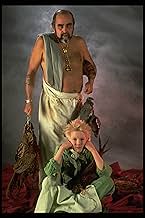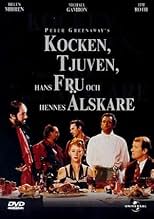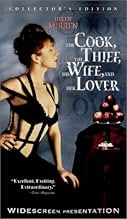El cocinero, el ladrón, su esposa y su amante
Título original: The Cook, the Thief, His Wife & Her Lover
La esposa de un criminal abusivo encuentra consuelo en los brazos de un hombre que visita regularmente el restaurante de su esposo.La esposa de un criminal abusivo encuentra consuelo en los brazos de un hombre que visita regularmente el restaurante de su esposo.La esposa de un criminal abusivo encuentra consuelo en los brazos de un hombre que visita regularmente el restaurante de su esposo.
- Premios
- 7 premios ganados y 11 nominaciones en total
Ciarán Hinds
- Cory
- (as Ciaran Hinds)
Roger Ashton-Griffiths
- Turpin
- (as Roger Ashton Griffiths)
- Dirección
- Guionista
- Todo el elenco y el equipo
- Producción, taquilla y más en IMDbPro
Opiniones destacadas
10miloc
Here's the weird secret of this movie: you might actually enjoy it.
Peter Greenaway once commented, "film is too important to be left in the hands of story- tellers." Like almost everything Godard ever said, it's a preposterous statement that ought to be heeded.
As a filmmaker Greenaway has always delighted in puzzle-pictures; from the twin-based symmetry of "A Zed and Two Naughts" to the subliminal counting-game of "Drowning by Numbers" to the mad frames-within-frames of "Prospero's Books" his films resemble nothing so much as one of Graeme Base's wonderful children's' books ("The Eleventh Hour" and "Animalia" for instance) brought to life. Plus, of course, a great deal of nudity and assorted nastiness-- enough to get the works of one of the most original filmmakers living a rather sordid reputation.
So, once you've recovered from the visceral shock of watching "The Cook, the Thief, His Wife and Her Lover" the first time, take a step back and watch it again. Yeah, I mean that, do it. Look at it this time as you might a painting by Heironymus Bosch: what appears to be a madman's chaotic hellscape turns out to have a precise allegorical order, and contains such a wealth of symbolism that one viewing cannot possibly be enough to absorb it all. A scene that may seem gratuitously horrific (a naked couple enclosed in a truck full of rotting meat-- probably the moment that jolted me the most) in fact reveals a medievalist's precision (Adam and Eve, cast from Paradise for the First Big Sin, are suddenly subject to the corruption of the flesh). An abstract concept is thus made perfectly and accessibly literal.
Different viewers may prefer to see this movie as religious allegory, political screed, or wry class commentary. The fact is it is all of these, and probably more. The irony of Greenaway's quote above is that he is in fact story-telling on several levels at once. (It's the same irony in the comment that "Seinfeld" was a "show about nothing" when in fact there was more going on per episode than in any other ten sitcoms. It just wasn't "simple.")
In response to criticism over the bloodshed in his movies, Godard once said "It isn't blood, it's red." Meaning: it's all part of a composition, the way color is used on a painter's canvas. It's there for a point, just like Greenaway's explicit yet elegant shocks. With that mind, watch this movie, and enjoy it. It's sharp, gruesomely witty, and as remarkable to look at as almost anything in the Met. If you can handle really thinking, you can handle this, and we all can, can't we?
Peter Greenaway once commented, "film is too important to be left in the hands of story- tellers." Like almost everything Godard ever said, it's a preposterous statement that ought to be heeded.
As a filmmaker Greenaway has always delighted in puzzle-pictures; from the twin-based symmetry of "A Zed and Two Naughts" to the subliminal counting-game of "Drowning by Numbers" to the mad frames-within-frames of "Prospero's Books" his films resemble nothing so much as one of Graeme Base's wonderful children's' books ("The Eleventh Hour" and "Animalia" for instance) brought to life. Plus, of course, a great deal of nudity and assorted nastiness-- enough to get the works of one of the most original filmmakers living a rather sordid reputation.
So, once you've recovered from the visceral shock of watching "The Cook, the Thief, His Wife and Her Lover" the first time, take a step back and watch it again. Yeah, I mean that, do it. Look at it this time as you might a painting by Heironymus Bosch: what appears to be a madman's chaotic hellscape turns out to have a precise allegorical order, and contains such a wealth of symbolism that one viewing cannot possibly be enough to absorb it all. A scene that may seem gratuitously horrific (a naked couple enclosed in a truck full of rotting meat-- probably the moment that jolted me the most) in fact reveals a medievalist's precision (Adam and Eve, cast from Paradise for the First Big Sin, are suddenly subject to the corruption of the flesh). An abstract concept is thus made perfectly and accessibly literal.
Different viewers may prefer to see this movie as religious allegory, political screed, or wry class commentary. The fact is it is all of these, and probably more. The irony of Greenaway's quote above is that he is in fact story-telling on several levels at once. (It's the same irony in the comment that "Seinfeld" was a "show about nothing" when in fact there was more going on per episode than in any other ten sitcoms. It just wasn't "simple.")
In response to criticism over the bloodshed in his movies, Godard once said "It isn't blood, it's red." Meaning: it's all part of a composition, the way color is used on a painter's canvas. It's there for a point, just like Greenaway's explicit yet elegant shocks. With that mind, watch this movie, and enjoy it. It's sharp, gruesomely witty, and as remarkable to look at as almost anything in the Met. If you can handle really thinking, you can handle this, and we all can, can't we?
Imagine the universe as a restaurant. The parking lot is the world. The kitchen is purgatory. The ladies's room is heaven. The dining room is hell. Hell is ruled over by Albert Spica, (Satan) excellently played by Michael Gobon. Dante is Michael (Alan Howard) a cataloger of French books. Beatrice, Dante's perfect woman, Georgina Spica (Helen Mirren) who is married to the devil.
In the beginning, the cook (God) in the real world is seen kicked and smeared and fed dog feces by Gabon. He is humiliated and in tears, but He endures and eventually helps to further the love between Howard and MIrren. Sex, in its pure form, is looked at as something sacred. Gabon lords over everyone in his realm with a tyrant's fist, caring nothing about anyone or anything. He wants two three things out of lifesuperiority to all other being, food and sex, while Mirren, as a reluctant Persephone, sneaks off to be with Howard. A couple of times Gabon even finds his way into the sanctity of heaven, but this is only short-lived.
The mood of the film is dark-black, heralded by brilliant reds or greens, and the tenor of an angelic child throughout. Every image is like a painting. Emotions creep in from all directions.
This is a film that would never, no matter what year it was produced, have won an Academy Award. It is too refined, to subtle, too sensual, too intelligent.
Watch it, rent it, buy it. It must be seen.
In the beginning, the cook (God) in the real world is seen kicked and smeared and fed dog feces by Gabon. He is humiliated and in tears, but He endures and eventually helps to further the love between Howard and MIrren. Sex, in its pure form, is looked at as something sacred. Gabon lords over everyone in his realm with a tyrant's fist, caring nothing about anyone or anything. He wants two three things out of lifesuperiority to all other being, food and sex, while Mirren, as a reluctant Persephone, sneaks off to be with Howard. A couple of times Gabon even finds his way into the sanctity of heaven, but this is only short-lived.
The mood of the film is dark-black, heralded by brilliant reds or greens, and the tenor of an angelic child throughout. Every image is like a painting. Emotions creep in from all directions.
This is a film that would never, no matter what year it was produced, have won an Academy Award. It is too refined, to subtle, too sensual, too intelligent.
Watch it, rent it, buy it. It must be seen.
I sat transfixed by this film's ability to become increasingly depraved, always without any redeeming quality whatsoever. We would have left except that I became fascinated by the ability of the director and writer to hit bottom and then keep drilling. The story is familiar enough but there are no protagonists. There really are no antagonists either. Just a bunch of people you care nothing about doing things you don't want to know about. If a friend did this stuff to another human and wanted to tell you about it, you would scream for him/her to stop.
To top it off it has a score by Michael Nyman who had just enough talent to write one bad film score and retreads it for every film that a producer is stupid enough to hire him to score.
To top it off it has a score by Michael Nyman who had just enough talent to write one bad film score and retreads it for every film that a producer is stupid enough to hire him to score.
This contains spoilers.
OK... so some people think this thing is ART. I don't get it.
The film's basic story is old: a bored woman wants to escape her rich, dominating, unfeeling and unintelligent husband and has an affair with a poor but sensitive man. Husband finds out and seeks revenge. Wife retaliates. This plot line has been done MANY times. Yawn.
The graphic violence is gratuitous and adds nothing to the film's story except to over emphasize how brutal the world of this couple is, show how mean the husband is, AND to give the "enlightened" movie "critics" something to which they can point as evidence that this is not a film for the "average" audience. The violence is so overdone, however, that its shock value wears off quickly, and the climactic "banquet" scene therefore has no real impact on the now numbed audience. Yawn.
The cinematography, lighting, costumes, sets, featured art pieces, and almost all visual aspects of the film are spectacularly lush - but like a heavy, rich meal they tend to overpower and make one sleepy or not very alert. What the point of the color changes in the costuming between the dining room, lavatory, kitchen, and garage sets was meant to do except to work as a gimmick to wake up the audience - or give more fodder to the "enlightened" ones who wanted to claim that this was something only those in tune with "Art" could understand - is never disclosed. Yawn.
In the end, only those who claimed to be "enlightened" applauded the film as a work of "Art". The rest of us unwashed masses either woke up when the "enlightened" ones applauded or numbly sat in our seats wondering why we spent money and wasted time to see this "artistic" piece of trash.
OK... so some people think this thing is ART. I don't get it.
The film's basic story is old: a bored woman wants to escape her rich, dominating, unfeeling and unintelligent husband and has an affair with a poor but sensitive man. Husband finds out and seeks revenge. Wife retaliates. This plot line has been done MANY times. Yawn.
The graphic violence is gratuitous and adds nothing to the film's story except to over emphasize how brutal the world of this couple is, show how mean the husband is, AND to give the "enlightened" movie "critics" something to which they can point as evidence that this is not a film for the "average" audience. The violence is so overdone, however, that its shock value wears off quickly, and the climactic "banquet" scene therefore has no real impact on the now numbed audience. Yawn.
The cinematography, lighting, costumes, sets, featured art pieces, and almost all visual aspects of the film are spectacularly lush - but like a heavy, rich meal they tend to overpower and make one sleepy or not very alert. What the point of the color changes in the costuming between the dining room, lavatory, kitchen, and garage sets was meant to do except to work as a gimmick to wake up the audience - or give more fodder to the "enlightened" ones who wanted to claim that this was something only those in tune with "Art" could understand - is never disclosed. Yawn.
In the end, only those who claimed to be "enlightened" applauded the film as a work of "Art". The rest of us unwashed masses either woke up when the "enlightened" ones applauded or numbly sat in our seats wondering why we spent money and wasted time to see this "artistic" piece of trash.
I saw this almost fifteen years ago and I still have crystal clear mental images of some of the scenes. The chef at his table in the kitchen, planning his menu: stunning! Put it in a frame, hang it on the wall. In the restaurant scenes, you feel like you're there at the table as the camera pans, without cuts, from one person to another. Our heroes locked in the truck full of rotting meat: horrible, disgusting, perfect. It's a classic purification ritual and it's literally putrid. Greenaway is a genius. My only criticism is a minor one. There is a full frontal nude scene of the wife and her lover, where he is clearly more "relaxed" than he should have been at that moment. I'm a bit disappointed in Greenaway for not showing him at "attention", as he would have been in real life. But then, I guess he would have been accused of making porn. Whatever. This film is not for everyone. My wife didn't see it. I'm sure she would have hated it if she had. For that matter, I can't actually say I liked it, although I consider it a masterwork. But I'm glad I saw it. I'll probably see it again, but not until I can see it on HDTV. Plain old DVD couldn't possibly do it justice. An amazing movie.
¿Sabías que…?
- TriviaThe four title characters were named for the actors and actress writer and director Peter Greenaway originally wanted to play them. Richard (The Cook) was for Richard Bohringer, the only one of Greenaway's original choices retained in the final movie. Albert (The Thief) was named after Albert Finney, while Georgina (His Wife) was for Georgina Hale. Michael (The Lover) was named, interestingly enough, for Sir Michael Gambon, who Greenaway eventually re-cast as Albert.
- ErroresWhen Albert (Michael Gambon) goes into the ladies' toilet and starts throwing women out of the cubicles, the second one has, as you would expect, her underwear around her knees. But her skirt rides right up, revealing that she is still wearing her underwear and that the ones below are a prop.
- Créditos curiososClosing credits epilogue: "And a special thanks to those very many people who patiently & repeatedly performed as patients & nurses in the hospital ward, and as diners in the Hollandais Restaurant."
- Versiones alternativasAn edited, R-rated version is available on video.
Selecciones populares
Inicia sesión para calificar y agrega a la lista de videos para obtener recomendaciones personalizadas
Detalles
- Fecha de lanzamiento
- Países de origen
- Sitio oficial
- Idiomas
- También se conoce como
- The Cook, the Thief, His Wife & Her Lover
- Locaciones de filmación
- Productoras
- Ver más créditos de la compañía en IMDbPro
Taquilla
- Total en EE. UU. y Canadá
- USD 7,724,701
- Fin de semana de estreno en EE. UU. y Canadá
- USD 252,223
- 8 abr 1990
- Total a nivel mundial
- USD 8,527,316
- Tiempo de ejecución2 horas 4 minutos
- Color
- Relación de aspecto
- 2.35 : 1
Contribuir a esta página
Sugiere una edición o agrega el contenido que falta

Principales brechas de datos
What is the streaming release date of El cocinero, el ladrón, su esposa y su amante (1989) in Brazil?
Responda





































